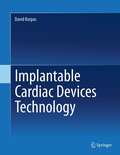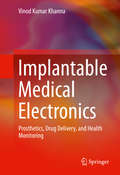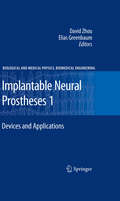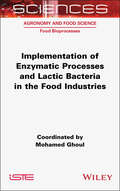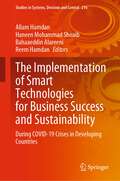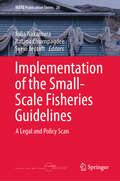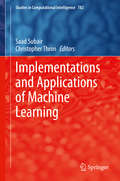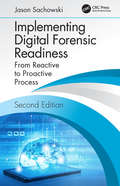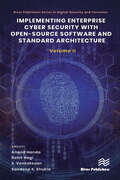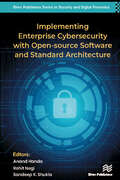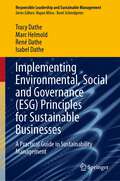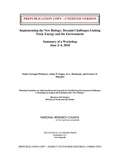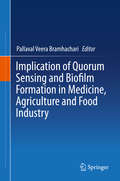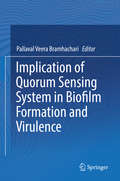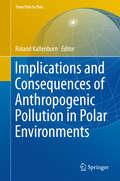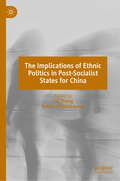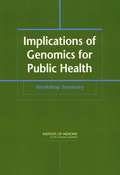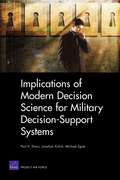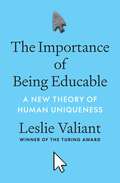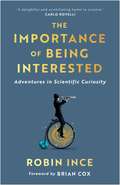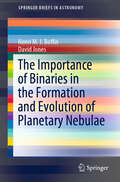- Table View
- List View
Implantable Cardiac Devices Technology
by David KorpasDevelopment in a majority of medicine branches today is based on technological advancement. This is the case in cardiology, where medical devices designed to correct heart rhythm - pacemakers, cardioverters-defibrillators and biventricular systems - are implanted in order to help a sick heart. Medical pacing devices today are only developed and produced globally by a several producers who make different technical solutions, algorithms, system parameters etc. The book Implantable Cardiac Devices Technology is targeted at biomedical, clinical engineers, technicians in practice, students of biomedical disciplines, and all medical staff who are required to understand the basics of pacing technology. The book is comprised of fourteen chapters that are further subdivided according to specific topics. Chapters dealing with basic heart anatomy, physiology and arythmology are included for the sake of comprehensiveness. Chapters avoid the description of special functions, but cover general procedures and parameters common for the systems of all producers. The book is intended to serve as a monothematic textbook. In order to make the text comprehensible and well arranged for a reader, references to professional literature are only provided once in a respective chapter.
Implantable Medical Electronics
by Vinod Kumar KhannaThis book is a comprehensive, interdisciplinary resource for the latest information on implantable medical devices, and is intended for graduate students studying electrical engineering, electronic instrumentation, and biomedical engineering. It is also appropriate for academic researchers, professional engineers, practicing doctors, and paramedical staff. Divided into two sections on Basic Concepts and Principles, and Applications, the first section provides an all-embracing perspective of the electronics background necessary for this work. The second section deals with pacing techniques used for the heart, brain, spinal cord, and the network of nerves that interlink the brain and spinal cord with the major organs, including ear and eye prostheses. The four main offshoots of implantable electronics, which this book discusses, are: The insertion of an implantable neural amplifier for accurate recording of neural signals for neuroengineering studies The use of implantable pulse generators for pacing the activities of diseased organs The use of implantable sensors for observing the influence of therapy and monitoring a patient's biological parameters The use of drug delivery systems to supervise the supply of accurate doses of medicine to affected parts Readers will also find chapters on the ess entials of clocking and timing circuits, pulse generator circuits, neural amplifiers, batteries, biomaterials and biocompatibility, and more. Unique to this book is also a chapter on cyber security and confidentiality concerns with implants. End-of-chapter questions and exercises help readers apply the content to practical use, making this an ideal book for anyone wishing to learn more about implantable devices.
Implantable Neural Prostheses 1
by David Zhou Elias GreenbaumThis book and its companion volume describe state-of-the-art advances in techniques associated with implantable neural prosthetic devices and their applications. Researchers, engineers, clinicians, students and any specialist in this field will gain a deeper understanding of the neural prosthetic techniques currently available for a wide range of biomedical applications. In part one of this two-volume sequence, Implantable Neural Prostheses 1: Devices and Applications, the focus is on implant designs and applications. Devices covered include sensory prosthetic devices such as cochlear implants, auditory midbrain implants, visual implants, spinal cord stimulators, and motor prosthetic devices including deep brain stimulators, Bions, and cardiac electro-stimulators. Readers will also understand the regulatory approval process in the U.S. and Europe for implantable medical devices.
Implementation of Enzymatic Processes and Lactic Bacteria in the Food Industries (ISTE Consignment)
by Mohamed GhoulConsumers are demanding healthy, natural food products with no environmental impacts. The use of ingredients of plant origin and the implementation of bioprocesses using enzymes and micro-organisms as biocatalysts represent a promising alternative to satisfy this demand. Implementation of Enzymatic Processes and Lactic Bacteria in the Food Industries focuses on describing the latest developments in the use of enzymatic biocatalysts and lactic acid bacteria in the food industry. The first part of the book is devoted to the presentation of different classes of enzymes, production and application processes, ways of improving enzymes and the main industrial applications using biocatalysts. The second part of the book describes a family of micro-organisms widely used in health food processing and formulation: lactic acid bacteria and bifidobacteria. Then, the most commonly used encapsulation matrices, encapsulation processes and the process of bacterial adhesion to these matrices are discussed. Finally, the best-known fermented foods and new approaches developed in this field are presented.
The Implementation of Smart Technologies for Business Success and Sustainability: During COVID-19 Crises in Developing Countries (Studies in Systems, Decision and Control #216)
by Allam Hamdan Haneen Mohammad Shoaib Bahaaeddin Alareeni Reem HamdanIndustry 4.0 technologies identified as the main contributor to the digitalization era. New technology delivers optimal outputs by utilization of effective resource. Therefore, smart technologies that has inventive and creative objects became critical to enterprise; recent studies shows that its led enterprises business such as SMEs to considerable investments, which many organizations over the world attempt to use innovative technologies such as IoT and AI, these technologies have potential on sustainable business models. In addition to that, innovation usage in business models led to significant benefits towards sustainability concept in SMEs marketplace. Furthermore, Sustainability objectives refers to corporate sustainability term, which integrate enterprise operations with social, educational, environmental and economic benefits, as process of decision-making can impact during sustainability implications. This book focus on the implementation of smart technologies for growing business, the book includes research articles and expository papers on the applications of technology on Decision Making, Healthcare, Smart Universities, Advertising, E-marketing, Public Sector and Digital Government, FinTech, RegTech. Some researchers also discussed the role of smart technologies in the current COVID-19 pandemic, whether in the health sector, education, and others. On all of these, the researchers discussed the impact of smart technologies on decision-making in those vital sectors of the economy.
Implementation of the Small-Scale Fisheries Guidelines: A Legal and Policy Scan (MARE Publication Series #28)
by Julia Nakamura Ratana Chuenpagdee Svein JentoftThis book provides a transdisciplinary assessment of multiple countries’ legal and policy frameworks vis-à-vis the Voluntary Guidelines for Securing Sustainable Small-Scale Fisheries in the Context of Food Security and Poverty Eradication, adopted in 2014 by the Committee on Fisheries of the Food and Agriculture Organization of the United Nations. Based on an appraisal framework used to facilitate the unpacking of those frameworks, this book collects country experiences and regional perspectives on a range of cross-cutting issues underpinning the protection of the rights and the promotion of justice for small-scale fishers and their communities.This book aims to be the first collection to present a systematic and in-depth assessment of existing national legal and policy frameworks vis-à-vis the SSF Guidelines. This assessment is done through the transdisciplinary and collaborative work of researchers, governments, and civil society organizations for the analysis of the cross-thematic questions, which the contributors of this book aim to address. Firstly, what are the relevant laws and policies that matter for securing rights of small-scale fishers and their communities? How are small-scale fisheries defined by national laws and policies? How are small-scale fisheries treated (i.e., specifically or generally) in these instruments? Are there specific provisions and references to small-scale fisheries or any of its associated terminologies (e.g., artisanal, subsistence, traditional, indigenous)? Secondly, how the relevant instruments address the 8 small-scale fisheries key issues outlined in that rapid appraisal study? What are the strengths and gaps in these instruments? Do they address issues that are not covered by the SSF Guidelines? Do they contribute to clarifying other legal issues that are relevant for sustainable small-scale fisheries? Finally, since the book also aims to explore the accessibility of these legal and policy instruments for those to which they matter the most (the small-scale fishers), the following questions were also considered: What challenges do they face in knowing and understanding the relevant laws and policies in place? Which tools, measures and processes are available in the countries to ensure small-scale fishers can claim for their rights? To what extent judicial courts have recognized and/or granted rights to small-scale fishers?Chapters 11 and 20 are available open access under a Creative Commons Attribution 4.0 International License via link.springer.com.
Implementations and Applications of Machine Learning (Studies in Computational Intelligence #782)
by Saad Subair Christopher ThronThis book provides step-by-step explanations of successful implementations and practical applications of machine learning. The book’s GitHub page contains software codes to assist readers in adapting materials and methods for their own use. A wide variety of applications are discussed, including wireless mesh network and power systems optimization; computer vision; image and facial recognition; protein prediction; data mining; and data discovery. Numerous state-of-the-art machine learning techniques are employed (with detailed explanations), including biologically-inspired optimization (genetic and other evolutionary algorithms, swarm intelligence); Viola Jones face detection; Gaussian mixture modeling; support vector machines; deep convolutional neural networks with performance enhancement techniques (including network design, learning rate optimization, data augmentation, transfer learning); spiking neural networks and timing dependent plasticity; frequent itemset mining; binary classification; and dynamic programming. This book provides valuable information on effective, cutting-edge techniques, and approaches for students, researchers, practitioners, and teachers in the field of machine learning.
Implementing Digital Forensic Readiness: From Reactive to Proactive Process, Second Edition
by Jason SachowskiImplementing Digital Forensic Readiness: From Reactive to Proactive Process, Second Edition presents the optimal way for digital forensic and IT security professionals to implement a proactive approach to digital forensics. The book details how digital forensic processes can align strategically with business operations and an already existing information and data security program. Detailing proper collection, preservation, storage, and presentation of digital evidence, the procedures outlined illustrate how digital evidence can be an essential tool in mitigating risk and redusing the impact of both internal and external, digital incidents, disputes, and crimes. By utilizing a digital forensic readiness approach and stances, a company’s preparedness and ability to take action quickly and respond as needed. In addition, this approach enhances the ability to gather evidence, as well as the relevance, reliability, and credibility of any such evidence. New chapters to this edition include Chapter 4 on Code of Ethics and Standards, Chapter 5 on Digital Forensics as a Business, and Chapter 10 on Establishing Legal Admissibility. This book offers best practices to professionals on enhancing their digital forensic program, or how to start and develop one the right way for effective forensic readiness in any corporate or enterprise setting.
Implementing Energy Efficiency in Industries
by G C RoyThis book focuses on designing, implementing, and verifying the performance of energy efficiency and conservation (EE&C) projects in relevant industries from a practitioner’s perspective. Various techniques and approaches are presented using case studies collated from the author’s notes from about four decades of working in process industries and two decades as an international sustainable energy consultant.Features: Provides a broad overview of the main issues in implementing energy efficiency in industries. Focuses on implementation issues – technical, financial and employee engagement. Provides a brief description on the fundamental thermodynamic principles that drive efficiency and conservation. Includes a comparative evaluation of ESCO performance contract implementation. Charts out the energy efficiency journey, developing long-term goals and short-term activities. Includes case studies related to energy efficiency in energy-intensive large industries. This book is aimed at professionals working in energy engineering, industry, efficiency, and policy.
Implementing Enterprise Cyber Security with Open-Source Software and Standard Architecture: Volume II (River Publishers Series in Digital Security and Forensics)
by Anand Handa Rohit Negi S. Venkatesan Sandeep K. ShuklaCyber security is one of the most critical problems faced by enterprises, government organizations, education institutes, small and medium scale businesses, and medical institutions today. Creating a cyber security posture through proper cyber security architecture, deployment of cyber defense tools, and building a security operation center are critical for all such organizations given the preponderance of cyber threats. However, cyber defense tools are expensive, and many small and medium-scale business houses cannot procure these tools within their budgets. Even those business houses that manage to procure them cannot use them effectively because of the lack of human resources and the knowledge of the standard enterprise security architecture. In 2020, the C3i Center at the Indian Institute of Technology Kanpur developed a professional certification course where IT professionals from various organizations go through rigorous six-month long training in cyber defense. During their training, groups within the cohort collaborate on team projects to develop cybersecurity solutions for problems such as malware analysis, threat intelligence collection, endpoint detection and protection, network intrusion detection, developing security incidents, event management systems, etc. All these projects leverage open-source tools, and code from various sources, and hence can be also constructed by others if the recipe to construct such tools is known. It is therefore beneficial if we put these recipes out in the form of book chapters such that small and medium scale businesses can create these tools based on open-source components, easily following the content of the chapters. In 2021, we published the first volume of this series based on the projects done by cohort 1 of the course. This volume, second in the series has new recipes and tool development expertise based on the projects done by cohort 3 of this training program. This volume consists of nine chapters that describe experience and know-how of projects in malware analysis, web application security, intrusion detection system, and honeypot in sufficient detail so they can be recreated by anyone looking to develop home grown solutions to defend themselves from cyber-attacks.
Implementing Enterprise Cybersecurity with Opensource Software and Standard Architecture
by Anand Handa Rohit Negi Sandeep Kumar ShuklaMany small and medium scale businesses cannot afford to procure expensive cybersecurity tools. In many cases, even after procurement, lack of a workforce with knowledge of the standard architecture of enterprise security, tools are often used ineffectively. The Editors have developed multiple projects which can help in developing cybersecurity solution architectures and the use of the right tools from the opensource software domain. This book has 8 chapters describing these projects in detail with recipes on how to use opensource tooling to obtain standard cyber defense and the ability to do self-penetration testing and vulnerability assessment. This book also demonstrates work related to malware analysis using machine learning and implementation of honeypots, network Intrusion Detection Systems in a security operation center environment. It is essential reading for cybersecurity professionals and advanced students.
Implementing Environmental, Social and Governance: A Practical Guide in Sustainability Management (Responsible Leadership and Sustainable Management)
by Tracy Dathe Marc Helmold René Dathe Isabel DatheThe concept of environmental, social and governance (ESG) is rapidly emerging as the new global industry standard and an important benchmarking tool for socially responsible investments. Major corporations seek the expertise of specialized consultants to develop and implement tailored ESG framework for their businesses. This book offers a guide to ESG and its practical applications. Beyond introducing the structured procedures of the most common ESG approaches, it delves into the comprehensive impact on the value chain, providing practical insights. The text explores the latest trends in various business sectors, offering insights into their ESG practices. Closing with a forward-looking perspective, the book anticipates future developments such as climate change management and ESG certifications, while also addressing potential pitfalls encapsulated by the term “greenwashing”.Written by authors with a solid background in teaching and research, the book establishes a robust theoretical foundation. The inclusion of numerous practical examples and country-specific recommendations enhances this book’s applicability and makes it an invaluable resource to those navigating the complexities of ESG.
Implementing Quality in Laboratory Policies and Processes: Using Templates, Project Management, and Six Sigma
by Donnell R. Christian Jr. Stephanie DrillingIn order to gain accreditation, every laboratory must have a superior quality assurance program. The keys to a successful program are the operational and technical manuals and associated documents which define the program and its various components. Written by experts with global experience in setting up laboratories, Implementing Quality in Labora
IMPLEMENTING THE NEW BIOLOGY: Decadal Challenges Linking Food, Energy, and the Environment
by National Research Council of the National AcademiesAs the second decade of the 21st century begins, the challenge of how to feed a growing world population and provide sustainable, affordable energy to fulfill daily needs, while also improving human health and protecting the environment, is clear and urgent. Increasing demand for food and energy is projected at the same time as the supply of land and other resources decrease. Increasing levels of greenhouse gasses alter climate, which, in turn, has life-changing implications for a broad range of plant and animal species. But promising developments are on the horizon--scientific discoveries and technologies that have the potential to contribute practical solutions to these seemingly intractable problems. As described in the 2009 National Research Council book, A New Biology for the 21st Century, biological research has experienced extraordinary scientific and technological advances in recent years that have allowed biologists to collect and make sense of ever more detailed observations at ever smaller time intervals. With these advances have come increasingly fruitful collaborations of biologists with scientists and engineers from other disciplines. A New Biology for the 21st Century called for a series of workshops to provide concrete examples of what New Biology research programs could look like. The present volume summarizes the first of those workshops, Implementing the New Biology: Decadal Challenges Linking Food, Energy, and the Environment.
Implication of Oxysterols and Phytosterols in Aging and Human Diseases (Advances in Experimental Medicine and Biology #1440)
by Gérard LizardThis book provides basic knowledge of the biology, chemistry, and function of oxysterols and its derivatives as well as of phytosterols in numerous human diseases. The book is divided into six sections and begins with an introduction to the biological and chemical properties of oxysterols and its derivatives as well as phytosterols, their synthesis, and the methods currently used for their detection in various biospecimens. The following section discusses in detail the various effects of oxysterols on numerous human diseases, including infectious diseases, inflammatory and autoimmune diseases, atherosclerosis, and cancer, as well as neurological and neuropsychiatric disorders. Importantly, the potential of oxysterols as biomarkers for some of these diseases is also highlighted. The book concludes with an outlook on the pharmacological and nutritional effects of oxysterols and phytosterols and their potential use by the food, and pharmaceutical industries. Aiming to provide an in-depth overview of the biological and the chemical properties of oxysterols and phytosterols and their implications for human health, this book will be of interest to basic and clinical scientists, as well as to anyone working in the food or pharmaceutical industry who is exploring the potential of oxysterols and phytosterols.
Implication of Quorum Sensing and Biofilm Formation in Medicine, Agriculture and Food Industry
by Pallaval Veera BramhachariThe book illustrates the role of quorum sensing in the food industry, agriculture, veterinary sciences, and medicine. It highlights the importance of quorum sensing in regulating diverse cellular functions in microbes, including virulence, pathogenesis, controlled-gene expression systems, and antibiotic resistance. This book also describes the role of quorum sensing in survival behavior and antibiotic resistance in bacteria. Further, it reviews the major role played by quorum sensing in food spoilage, biofilm formation, and food-related pathogenesis. It also explores the methods for the detection and quantification of quorum sensing signals. It also presents antimicrobial and anti-quorum sensing activities of medicinal plants. Finally, the book elucidates a comprehensive yet representative description of basic and applied aspects of quorum sensing inhibitors. This book serves an ideal guide for researchers to understand the implications of quorum sensing in the food industry, medicine, and agriculture.
Implication of Quorum Sensing System in Biofilm Formation and Virulence
by Pallaval Veera BramhachariThis book illustrates the importance and significance of Quorum sensing (QS), it’s critical roles in regulating diverse cellular functions in microbes, including bioluminescence, virulence, pathogenesis, gene expression, biofilm formation and antibiotic resistance. Microbes can coordinate population behavior with small molecules called autoinducers (AHL) which serves as a signal of cellular population density, triggering new patterns of gene expression for mounting virulence and pathogenesis. Therefore, these microbes have the competence to coordinate and regulate explicit sets of genes by sensing and communicating amongst themselves utilizing variety of signals. This book descry emphasizes on how bacteria can coordinate an activity and synchronize their response to external signals and regulate gene expression. The chapters of the book provide the recent advancements on various functional aspects of QS systems in different gram positive and gram negative organisms. Finally, the book also elucidates a comprehensive yet a representative description of a large number of challenges associated with quorum sensing signal molecules viz. virulence, pathogenesis, antibiotic synthesis, biosurfactants production, persister cells, cell signaling and biofilms, intra and inter-species communications, host-pathogen interactions, social interactions & swarming migration in biofilms.
Implications and Consequences of Anthropogenic Pollution in Polar Environments
by Roland KallenbornThe first evidence on the adverse effects of organic pollutants on Arctic ecosystems was provided by international research initiatives more than 30 years ago. Today, the indigenous people of the North are considered to be affected by exposure to persistent organic pollutants (POPs) and metals through their traditional marine food sources. The occurrence of pollutants of emerging concern in remote Polar environments is considered an essential criterion for prioritising this (largely neglected) type of contamination in national, international and global regulation schemes. Initiated during the first international Polar Years (IPY 2007-2009) and continued afterwards, 11 representative initiatives and projects are summarised as chapters in this book, which highlights today's interdisciplinary research on POPs in the Polar environment. The individual chapters describe in detail the consequences, priorities and perspectives of international research on POPs (legacy and emerging xenobiotics), its implications for regulations and scientific priorities including societal and cultural developments in the Arctic, as well as conservation priorities in Antarctica. This book is intended for all readers interested in learning more about modern research on environmental pollutants in the Polar environments (with a strong focus on Arctic environments). The impacts of pollution and climate change on Polar regions and the world as a whole will continue to be felt for many years to come. Sound science is, thus, vital in order to underpin actions that need to be taken at the global, regional and local levels. This book contributes to this highly relevant, interdisciplinary environmental scientific endeavour.
The Implications of Ethnic Politics in Post-Socialist States for China
by Chi Zhang Gulnara DadabayevaThis book examines the intricate and under-explored dynamics of ethnic politics in post-socialist states and their implications for China. While focusing on the political, cultural, and ethnic landscapes of Central Asia and their connections to China, the volume highlights how shared historical legacies and emerging geopolitical realities shape ethnic policies and state relations. Contributions from scholars based in the UK, Kazakhstan, and China provide a comprehensive analysis of key issues, including the influence of post-Soviet ethnic politics on China’s governance of its own minority regions, the challenges of nation-building, and China's growing geopolitical presence in Central Asia.
Implications of Genomics for Public Health: Workshop Summary
by Institute of Medicine of the National AcademiesThe National Academies Press (NAP)--publisher for the National Academies--publishes more than 200 books a year offering the most authoritative views, definitive information, and groundbreaking recommendations on a wide range of topics in science, engineering, and health. Our books are unique in that they are authored by the nation's leading experts in every scientific field.
Implications of Modern Decision Science for Military Decision-Support Systems
by Jonathan Kulick Michael Egner Paul K. DavisA selective review of modern decision science and implications for decision-support systems. The study suggests ways to synthesize lessons from research on heuristics and biases with those from "naturalistic research." It also discusses modern tools, such as increasingly realistic simulations, multiresolution modeling, and exploratory analysis, which can assist decisionmakers in choosing strategies that are flexible, adaptive, and robust.
Implications of Pyrite Oxidation for Engineering Works
by A. Brian HawkinsThe book highlights and analyses the distress to buildings caused by sulphate-induced heave, with particular reference to the recent problems in the Dublin area of Ireland. It describes the formation of pyrite, the processes involved in its oxidation and the various ways in which consequential expansion takes place. For the first time in the literature it discusses the way that buildings can be raised above their supporting foundation walls by the expansion of pyritiferous fill which has been used beneath ground-bearing floor slabs in Ireland. The significance of fractures through the iron sulphide microcrystals for the rate and extent of oxidation is discussed. Photographs and profiles of sulphate ingress into concrete/concrete blocks are presented. Case histories from the UK, North America and Ireland are discussed.
The Importance of Being Educable: A New Theory of Human Uniqueness
by Leslie ValiantIn the age of AI, why our future depends on better understanding what makes us humanWe are at a crossroads in history. If we hope to share our planet successfully with one another and the AI systems we are creating, we must reflect on who we are, how we got here, and where we are heading. The Importance of Being Educable puts forward a provocative new exploration of the extraordinary facility of humans to absorb and apply knowledge. The remarkable &“educability&” of the human brain can be understood as an information processing ability. It sets our species apart, enables the civilization we have, and gives us the power and potential to set our planet on a steady course. Yet it comes hand in hand with an insidious weakness. While we can readily absorb entire systems of thought about worlds of experience beyond our own, we struggle to judge correctly what information we should trust.In this visionary book, Leslie Valiant argues that understanding the nature of our own educability is crucial to safeguarding our future. After breaking down how we process information to learn and apply knowledge, and drawing comparisons with other animals and AI systems, he explains why education should be humankind&’s central preoccupation.Will the unique capability that has been so foundational to our achievements and civilization continue to drive our progress, or will we fall victim to our vulnerabilities? If we want to play to our species&’ great strength and protect our collective future, we must better understand and prioritize the vital importance of being educable. This book provides a road map.
The Importance of Being Interested: Adventures in Scientific Curiosity
by Robin Ince"A delightful and scintillating hymn to science." —Carlo Rovelli Comedian Robin Ince quickly abandoned science at school, bored by a fog of dull lessons and intimidated by the barrage of equations. But, twenty years later, he fell in love and he now presents one of the world's most popular science podcasts. Every year he meets hundreds of the world's greatest thinkers. In this erudite and witty book, Robin reveals why scientific wonder isn't just for the professionals. Filled with interviews featuring astronauts, comedians, teachers, quantum physicists, neuroscientists and more - as well as charting Robin's own journey with science - The Importance of Being Interested explores why many wrongly think of the discipline as distant and difficult. From the glorious appeal of the stars above to why scientific curiosity can encourage much needed intellectual humility, this optimistic and profound book will leave you filled with a thirst for intellectual adventure.
The Importance of Binaries in the Formation and Evolution of Planetary Nebulae (SpringerBriefs in Astronomy)
by Henri M. Boffin David JonesIt is now clear that a binary evolutionary pathway is responsible for a significant fraction of all planetary nebulae, with some authors even going so far as to claim that binarity may be a near requirement for the formation of an observable nebula. This has led to the requirement that textbooks most likely need to be rewritten. Building upon the review of Jones and Boffin in Nature Astronomy (2017), this Springer Brief takes a first step in this direction. It offers the first expanded presentation of all the theoretical and observational support for the importance of binarity in the formation of planetary nebulae, initially focusing on common envelope evolution but also covering wider binaries. This book emphasises the wider impact of the field, highlighting the critical role binary central stars of planetary nebulae have in understanding a plethora of astrophysical phenomena, including type Ia supernovae, chemically peculiar stars and circumbinary exoplanets.
